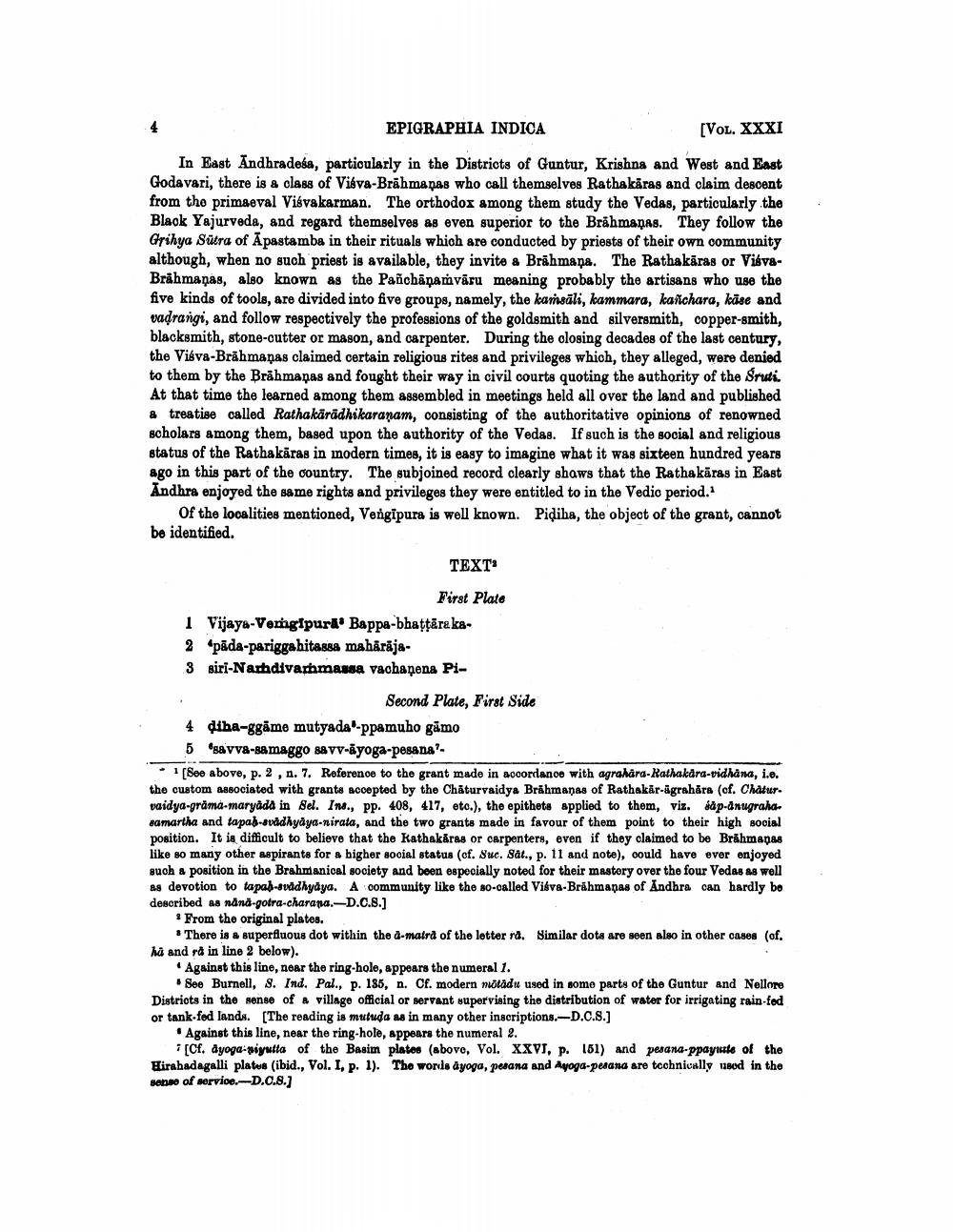________________
EPIGRAPHIA INDICA
[VOL. XXXI
In East Andhradeśa, particularly in the Districts of Guntur, Krishna and West and East Godavari, there is a class of Visva-Brāhmaṇas who call themselves Rathakāras and claim descent from the primaeval Visvakarman. The orthodox among them study the Vedas, particularly the Black Yajurveda, and regard themselves as even superior to the Brahmanas. They follow the Grihya Sūtra of Āpastamba in their rituals which are conducted by priests of their own community although, when no such priest is available, they invite a Brāhmaṇa. The Rathakāras or VisvaBrāhmaṇas, also known as the Panchāņavāru meaning probably the artisans who use the five kinds of tools, are divided into five groups, namely, the karsāli, kammara, kaschara, käse and vadrangi, and follow respectively the professions of the goldsmith and silversmith, copper-smith, blacksmith, stone-cutter or mason, and carpenter. During the closing decades of the last century, the Vibva-Brāhmaṇas claimed certain religious rites and privileges which, they alleged, were denied to them by the Brahmanas and fought their way in civil courts quoting the authority of the Sruti. At that time the learned among them assembled in meetings held all over the land and published & treatise called Rathakärädhikaranam, consisting of the authoritative opinions of renowned scholars among them, based upon the authority of the Vedas. If such is the social and religious status of the Rathakäras in inodern times, it is easy to imagine what it was sixteen hundred years ago in this part of the country. The subjoined record clearly shows that the Rathakāras in East Andhra enjoyed the same rights and privileges they were entitled to in the Vedio period.
of the localities mentioned, Vengipura is well known. Pițiha, the object of the grant, cannot be identified.
TEXT
First Plate 1 Vijaya-Vergipurd' Bappa-bhattāra ka2 'pāda-pariggabitassa mahārāja3 siri-Nachdivammassa vachanena Pi
Second Plate, First Side 4 diha-ggāme mutyada-ppamuho gamo
5 savva-samaggo savv-âyoga-pesana? * *[See above, p. 2, n. 7. Referenoe to the grant made in accordance with agrahara-Rathakara-vidhana, i.e. the custom associated with grants sooopted by the Chäturvaidya Brahmanas of Rathakar-agrahāra (cf. Chatur. vaidya-gráma-maryada in Sel. Ins., pp. 408, 417, etc.), the epithets applied to them, viz. Sap.dnugraha. samartha and tapab svådhyāya-nirata, and the two grants made in favour of them point to their high social position. It is difficult to believe that the Kathakäras or carpenters, even if they claimed to be Brāhmanas like so many other aspirants for a higher social status (cf. Suc. Sal., p. 11 and note), could have ever enjoyed such a position in the Brahmanical society and been especially noted for their mastory over the four Vedas as well As devotion to tapah-svådhyāya. A community like the so-called Visva-Brāhmaṇas of Andhra can hardly bo described as nana-gotra-charana.-D.C.8.]
From the original plates.
• There is a superfluous dot within the d-malrd of the letter ra. Similar dots are seen also in other cases (of. hi and rd in line 2 below).
Against this line, near the ring-hole, appears the numeral 1.
See Burnell, s. Ind. Pal., p. 185, n. Cf. modern mõtadu used in some parts of the Guntur and Nellore Districts in the sense of a village official or servant supervising the distribution of water for irrigating rain-fed or tank.fed lands. [The reading is mutuda as in many other inscriptions.-D.C.S.)
. Against this line, near the ring-hole, appears the numeral 2.
[Cf. dyoga-riyutta of the Basim platos (above, Vol. XXVI, p. 151) and pesana-ppayout of the Hirahadagalli platus (ibid., Vol. I, p. 1). The words ayoga, pesana and Ayoga-pesana are tochnically sod in the sense of service.-D.0.8.]




